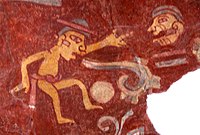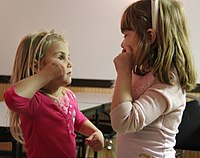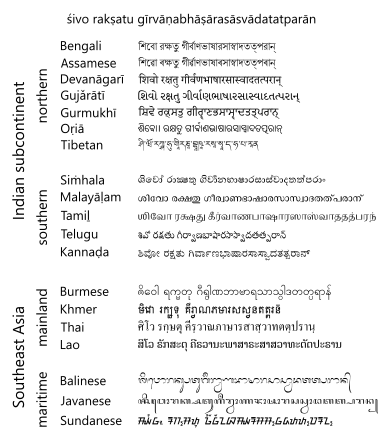Portal:Language
Introduction




Language is a structured system of communication that consists of grammar and vocabulary. It is the primary means by which humans convey meaning, both in spoken and written forms, and may also be conveyed through sign languages. Human language is characterized by its cultural and historical diversity, with significant variations observed between cultures and across time. Human languages possess the properties of productivity and displacement, which enable the creation of an infinite number of sentences, and the ability to refer to objects, events, and ideas that are not immediately present in the discourse. The use of human language relies on social convention and is acquired through learning.
Estimates of the number of human languages in the world vary between 5,000 and 7,000. Precise estimates depend on an arbitrary distinction (dichotomy) established between languages and dialects. Natural languages are spoken, signed, or both; however, any language can be encoded into secondary media using auditory, visual, or tactile stimuli – for example, writing, whistling, signing, or braille. In other words, human language is modality-independent, but written or signed language is the way to inscribe or encode the natural human speech or gestures.
Depending on philosophical perspectives regarding the definition of language and meaning, when used as a general concept, "language" may refer to the cognitive ability to learn and use systems of complex communication, or to describe the set of rules that makes up these systems, or the set of utterances that can be produced from those rules. All languages rely on the process of semiosis to relate signs to particular meanings. Oral, manual and tactile languages contain a phonological system that governs how symbols are used to form sequences known as words or morphemes, and a syntactic system that governs how words and morphemes are combined to form phrases and utterances.
The scientific study of language is called linguistics. Critical examinations of languages, such as philosophy of language, the relationships between language and thought, how words represent experience, etc., have been debated at least since Gorgias and Plato in ancient Greek civilization. Thinkers such as Jean-Jacques Rousseau (1712–1778) have argued that language originated from emotions, while others like Immanuel Kant (1724–1804) have argued that languages originated from rational and logical thought. Twentieth century philosophers such as Ludwig Wittgenstein (1889–1951) argued that philosophy is really the study of language itself. Major figures in contemporary linguistics of these times include Ferdinand de Saussure and Noam Chomsky. (Full article...)
Selected language -

Hawaiian (ʻŌlelo Hawaiʻi, pronounced [ʔoːˈlɛlo həˈvɐjʔi]) is a Polynesian language and critically endangered language of the Austronesian language family that takes its name from Hawaiʻi, the largest island in the tropical North Pacific archipelago where it developed. Hawaiian, along with English, is an official language of the US state of Hawaii. King Kamehameha III established the first Hawaiian-language constitution in 1839 and 1840.
In 1896, the Republic of Hawaii established English as the official language in schools. The number of native speakers of Hawaiian gradually decreased during the period from the 1830s to the 1950s. English essentially displaced Hawaiian on six of seven inhabited islands. In 2001, native speakers of Hawaiian amounted to less than 0.1% of the statewide population. Linguists were unsure if Hawaiian and other endangered languages would survive. (Full article...)Did you know (auto-generated)

- ... that Annie Kanahele opposed the addition of diacritics to a reprint of the Bible in Hawaiian, arguing that the original exemplified the written Hawaiian language at the time of translation?
- ... that María Teresa Sesé wrote 500 romance novels in her native Spanish, then wrote several books in Basque after studying the language for two years?
- ... that Franzisca Baruch designed several Hebrew fonts, the cover of the first Israeli passport, the emblem of Jerusalem, and the logo of the Ha'aretz newspaper, all while barely knowing Hebrew?
- ... that the software-testing framework pytest has been described as a key ecosystem project for the Python programming language?
- ... that Indian singer Sudakshina Sarma sang in Assamese as Mahatma Gandhi's ashes were immersed in the Brahmaputra River?
- ... that Prey is the first feature film to have a full Comanche language dub?
More did you know -
- ...that the Permanent North American Gaeltacht (pictured) is an officially designated Irish speaking area in English/French speaking Ontario, Canada, the first of its kind outside of Ireland?
- ...that Englog is English mixed with Tagalog words, while Taglish is Tagalog mixed with English words, both being macaronic languages?
- ...that some 19th-century newspapers in South Australia published articles in the Cornish dialect of English to meet the needs of miners who had migrated there?
- ...that the Halegannada, literally "old Kannada", is an ancient form of the Kannada language?
Categories
Linguistics: Computational linguistics • Grammar • Historical linguistics • Morphology • Phonetics • Phonology • Pragmatics • Reading • Semantics • Sociolinguistics • Syntax • Writing
Languages: Language families • Pidgins and creoles • Sign languages
Linguists: By nationality • Historical linguists • Morphologists • Phoneticians • Phonologists • Sociolinguists • Syntacticians • Translators
Stubs: Constructed languages • Languages • Linguists • Pidgins and creoles • Typography • Vocabulary and usage • Writing systems
Full Language category tree
|
|---|
|
Select [►] to view subcategories
|
Related portals
Selected topic -
Western Armenian (Western Armenian: Արեւմտահայերէն, romanized: Arevmdahayeren [ɑɾɛvmədɑhɑjɛˈɾɛn]) is one of the two standardized forms of Modern Armenian, the other being Eastern Armenian. It is based mainly on the Istanbul Armenian dialect, as opposed to Eastern Armenian, which is mainly based on the Yerevan Armenian dialect.
Until the early 20th century, various Western Armenian dialects were also spoken in the Ottoman Empire, especially in the eastern regions historically populated by Armenians known as Western Armenia. The spoken or dialectal varieties of Western Armenian currently in use include Homshetsi, spoken by the Hemshin peoples; the dialects of Armenians of Kessab, Latakia and Jisr al-Shughur of Syria, Anjar of Lebanon, and Istanbul and Vakıflı, of Turkey (part of the "Sueidia" dialect). Sasun and Mush dialect is also spoken in modern-day Armenia villages such as Bazmaberd and Sasnashen. The Cilician dialect is also spoken in Cyprus, where it is taught in Armenian schools (Nareg), and is the first language of about 3,000 people of Armenian descent. (Full article...)Selected picture -

The Phoenician alphabet was a non-pictographic consonantal alphabet, or abjad. It became one of the most widely used writing systems, spread by Phoenician merchants across the Mediterranean world, where it evolved and was assimilated by many other cultures. The Aramaic alphabet, a modified form of Phoenician, was the ancestor of modern Arabic script, while Hebrew script is a stylistic variant of the Aramaic script. The Greek alphabet (and by extension its descendants such as the Latin, the Cyrillic and the Coptic), was a direct successor of Phoenician, though certain letter values were changed to represent vowels.
Language News
- 1 January 2024 – Public Domain Day
- The animated short film Steamboat Willie, the German-language version of the novel All Quiet on the Western Front, and other works published in 1928 enter the public domain in the United States. (Mashable)
Topics

Languages of Africa: Arabic, Chadic, Cushitic, Kanuri, Maasai, Setswana, Swahili, Turkana, Xhosa, Yoruba, Zulu, more...
Languages of the Americas: Aleut, Carib, Cherokee, Inuktitut, Iroquois, Kootenai, Mayan, Nahuatl, Navajo, Quechuan, Salish, American Sign Language, more...
Languages of Asia: Arabic, Assamese, Balochi, Bengali, Chinese, Japanese, Hajong, Hebrew, Hindustani, Kannada, Kokborok, Marathi, Khasi, Korean, Kurdish, Malayalam, Manipuri, Meithei, Mongolian, Persian, Rajasthani, Sindhi, Sanskrit, Sylheti, Tamil, Tanchangya, Tulu, Telugu, Tibetan, Thai, Turkish, Vietnamese, Khowar, more...
Languages of Austronesia: Austric, Fijian, Hawaiian, Javanese, Malagasy, Malay, Maori, Marshallese, Samoan, Tahitian, Tagalog, Tongan, Auslan, more...
Languages of Europe: Basque, Czech, Danish, Dutch, English (book), French, German, Greek, Italian, Latin, Leonese, Norwegian, Polish, Portuguese, Romanian, Russian, Slovak, Spanish, Ukrainian more...
Constructed languages: Esperanto, Ido, Volapük, more...
Agglutinative language, Analytic language, Constructed language, Creole, Context-free language, Extinct language, Dialect, Fusional language, Inflectional language, International language, Isolating language, Language isolate, National language, Natural language, Pidgin, Pluricentric language, Polysynthetic language, Proto-language, Sign language, Spoken language, Synthetic language, Variety (linguistics)

Applied linguistics, Cognitive linguistics, Accent (dialect), Computational linguistics, Descriptive linguistics, Eurolinguistics, Generative linguistics, Historical linguistics, Lexicology, Lexical semantics, Morphology, Onomasiology, Phonetics, Phonology, Pragmatics, Prescription, Prototype semantics, Psycholinguistics, Semantics, Stylistics, Sociolinguistics, Syntax
See also: List of linguists

Alphabets: Arabic alphabet, Bengali alphabet, Cyrillic alphabet, Hebrew alphabet, Latin alphabet, more...
Other writing systems: Abjad, Abugida, Braille, Hieroglyphics, Logogram, Syllabary, SignWriting, more..
See also: History of the alphabet, Script
Associated Wikimedia
The following Wikimedia Foundation sister projects provide more on this subject:
-
Commons
Free media repository -
Wikibooks
Free textbooks and manuals -
Wikidata
Free knowledge base -
Wikinews
Free-content news -
Wikiquote
Collection of quotations -
Wikisource
Free-content library -
Wikiversity
Free learning tools -
Wiktionary
Dictionary and thesaurus
Find a language
| Enter an ISO 639 code to find the corresponding language article |























